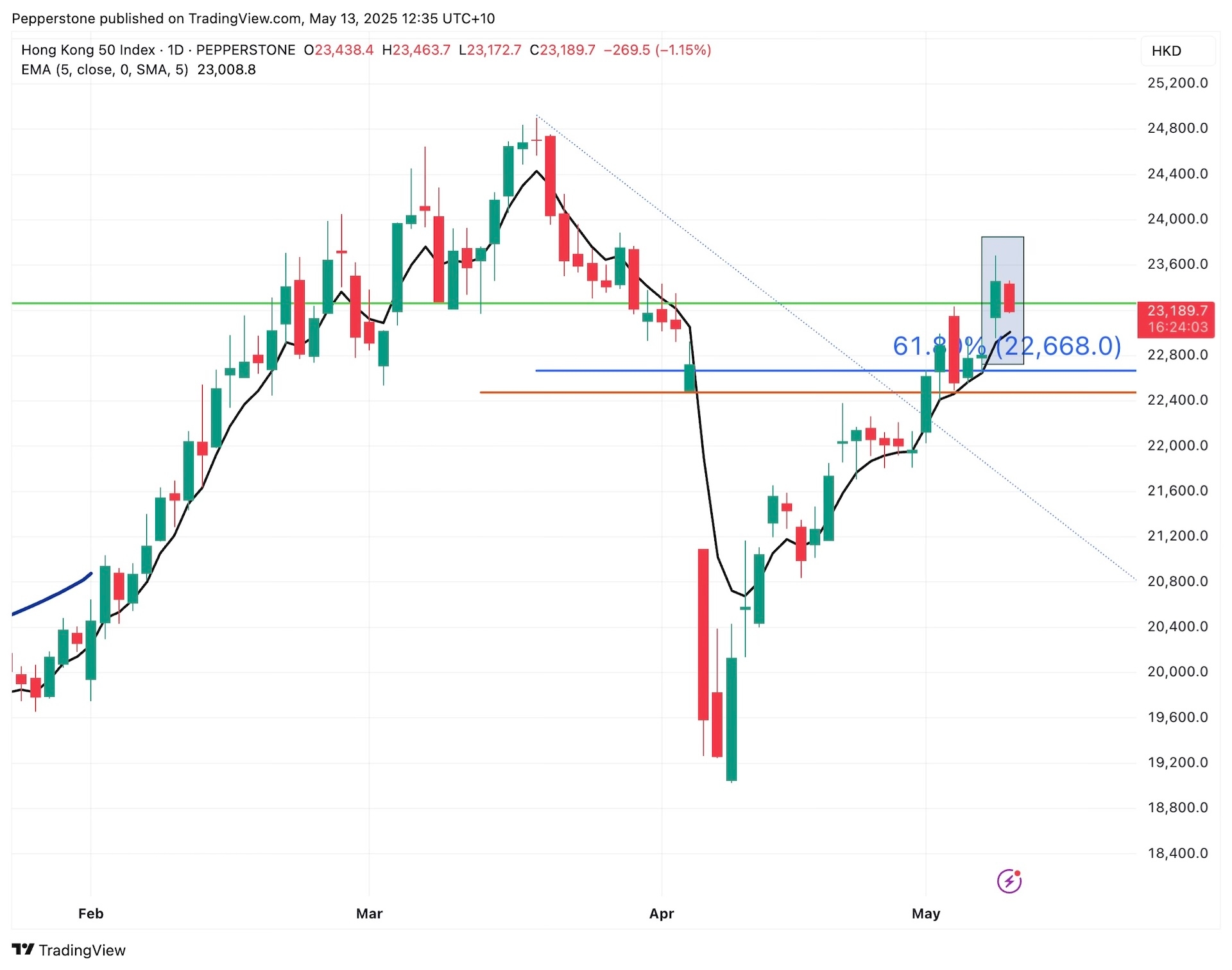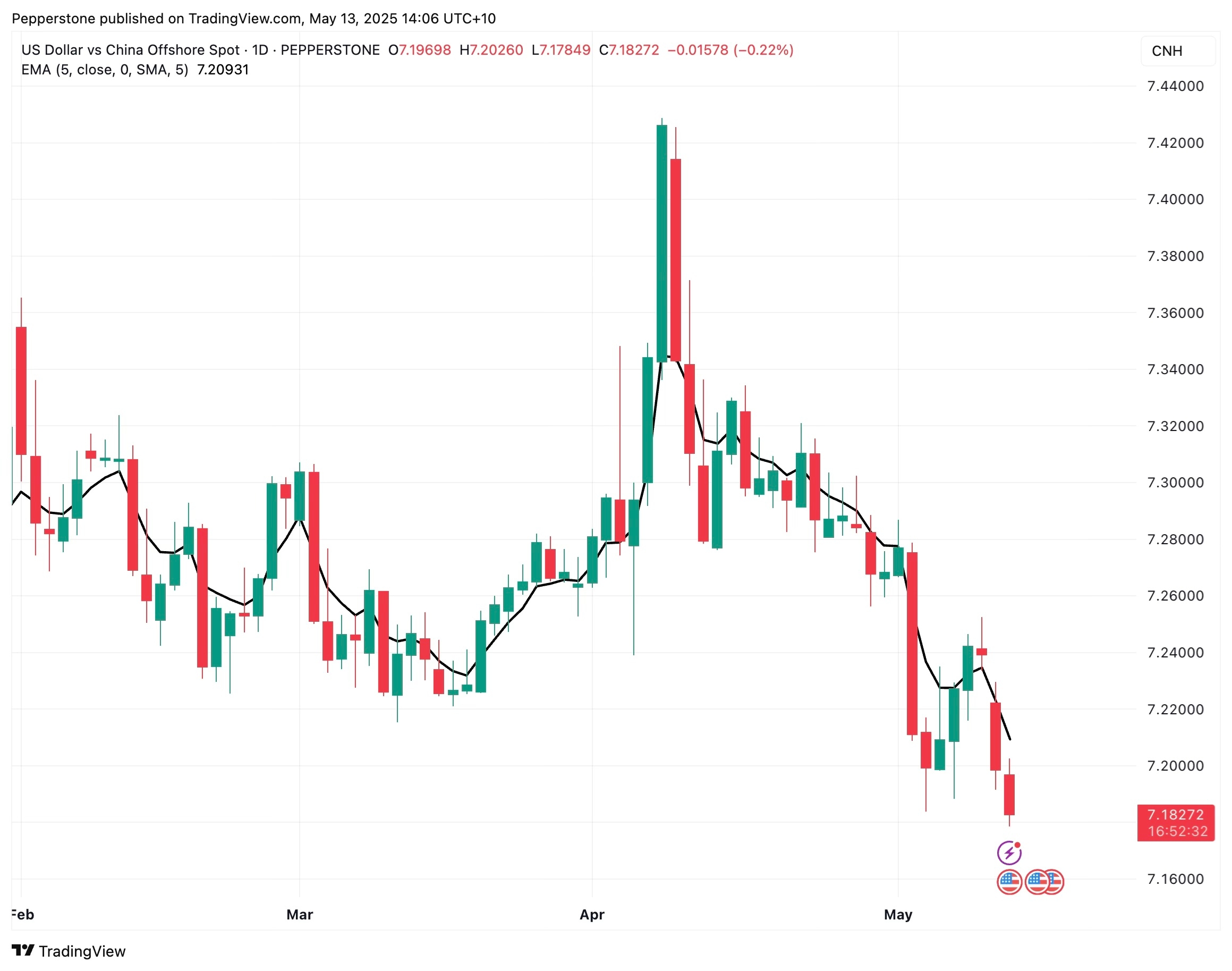Analysis
The outcome of the US-China tariff talks significantly exceeded market expectations, and optimism quickly reflected in the capital markets, with the Hang Seng Index surging nearly 2.9% in a single day. However, the optimism was short-lived as bearish traders quickly covered their positions the following day, causing the market to weaken again.

This reversal has left traders wondering: why did markets retreat just as the "good news" landed? What unresolved issues still lurk beneath this temporary pause in negotiations? And what macroeconomic signals will shape the next chapter of this complex standoff?
Stagflation Risk Pressures U.S. to Deal
From a macroeconomic perspective, tariffs hit China and the U.S. in very different ways. For the U.S., tariffs amount to a supply-side shock - one that may eventually drive up inflation and squeeze corporate profit margins. For China, the impact is more demand-side, directly weighing on exports and investment.
In the near term, U.S. data still shows resilience. April’s nonfarm payrolls beat expectations, and both manufacturing and services PMIs beat expectations. Low oil prices and a front-loading of imports have also kept inflation in check. But if high tariffs persist, the stagflation scenario that Fed Chair Jerome Powell fears could become increasingly real - slowing growth alongside stubborn inflation. That would severely limit the Fed’s room to ease policy in response to a downturn.
Politically, the 2026 U.S. midterm elections are fast approaching, and fiscal constraints are tightening. With national debt ballooning to $36 trillion, the issue is no longer just about deficits - it’s a structural crisis. Tariffs, deficits, and debt form a toxic triangle, making the negotiations not optional for Washington, but imperative.
China Moves Proactively to Stabilize Expectations
In contrast, China has taken a more measured and proactive approach. Ahead of the tariff talks and the upcoming Fed meeting, Beijing rolled out a series of easing measures designed to anchor market expectations. I believe there are two main reasons behind this timing.
First, launching stimulus during the post-holiday lull and following weaker April PMI figures helps cushion downside pressure on the economy. Second, by aligning these moves with a window of CNY/CNH appreciation, China has helped ease concerns about capital outflows and currency volatility.

On the policy front, the stimulus package includes a 50-basis-point cut to reserve requirements for major banks, targeted RRR reductions for auto finance and leasing firms to zero, a 10-basis-point policy rate cut, lower interest rates on various policy-backed tools, and expanded quotas for targeted lending programs.
Capital markets have also joined the effort. Authorities have merged market support tools, loosened restrictions on insurance capital entering the market, and directed financial institutions to establish dedicated investment units focused on tech equities and innovation bonds.
This stimulus wave isn’t just about boosting sentiment - it aims to revive domestic demand through structural credit expansion, channeling capital into tech upgrades, green consumption, and elderly care services. These moves support long-term rebalancing and reduce reliance on external demand, turning passive pressure from tariffs into a foundation for future resilience.
China’s export diversification strategy is also gaining traction. While Q1 exports to the U.S. fell 11.2% year-on-year, exports to ASEAN and the EU rose by 8.4% and 3.6% respectively, enhancing China’s bargaining position in future negotiations.
A Deal Signed, But the Trade War May Just Be Beginning
Although both sides have agreed to pause new tariff measures, the fundamental tensions remain unresolved. In fact, the tariffs - originally a tool for punishment amid a near-freeze in trade - may now serve as actual leverage in a renewed negotiation phase as trade flows recover.
Bringing tariffs down from “irrational” levels to more manageable rates relieve inflationary pressure in the U.S. and provides breathing room for China’s exports and domestic demand. Still, the current 30% average tariff rate remains a significant burden on Chinese firms, while the U.S. continues to wrestle with unresolved fiscal and trade imbalances. Any agreement, therefore, could be more of a temporary ceasefire than a lasting solution.
Meanwhile, Washington may escalate tensions in other arenas - from tighter sanctions on Chinese tech firms and stricter export controls on critical components, to pushing supply chain rerouting through Southeast Asia and Mexico. In other words, the battleground may shift, but the rivalry will endure.
What’s Next?
Even with trade tensions easing for now, markets remain cautious. Q2 will be critical for gauging policy directions and sentiment shifts on both sides.
When it comes to the tariff negotiations, both sides have already backed away from tariffs above 100%, making it highly unlikely we’ll see anything near that level again. That said, Treasury Secretary Bessent has hinted at a potential new Chinese purchase agreement. But history offers a cautionary tale: if China, like in 2019, maintains the upper hand in negotiations while adopting a “promise without delivery” strategy, it could erode U.S. leverage further - and in turn, lend stronger support to Chinese assets.
Investors are now closely watching for real progress across three fronts in the U.S.: tariff negotiations, tax cuts, and rate reductions. Without at least one or two concrete outcomes, risk asset valuations could come under pressure again as tariff-related risks are repriced.
In China, the current tariff truce has already helped mitigate some external risk. Many believe the 5% annual growth target can be met without massive new stimulus. However, if economic data improves meaningfully in Q2, the July Politburo meeting could mark the next policy pivot. Against the backdrop of AI-led market optimism and stimulus-driven domestic demand, tech and consumer sectors remain key areas to watch.
All in all, a tariff truce does not mean the risks are gone. A resumption of trade flows does not mean trust has been rebuilt. The U.S.-China negotiations are far from over - and markets will continue to search for balance between optimism and caution.
The material provided here has not been prepared in accordance with legal requirements designed to promote the independence of investment research and as such is considered to be a marketing communication. Whilst it is not subject to any prohibition on dealing ahead of the dissemination of investment research we will not seek to take any advantage before providing it to our clients. Pepperstone doesn’t represent that the material provided here is accurate, current or complete, and therefore shouldn’t be relied upon as such. The information, whether from a third party or not, isn’t to be considered as a recommendation; or an offer to buy or sell; or the solicitation of an offer to buy or sell any security, financial product or instrument; or to participate in any particular trading strategy. It does not take into account readers’ financial situation or investment objectives. We advise any readers of this content to seek their own advice. Without the approval of Pepperstone, reproduction or redistribution of this information isn’t permitted.
.jpg)